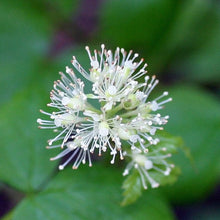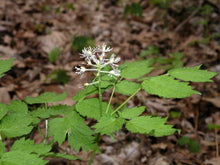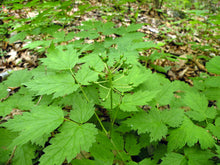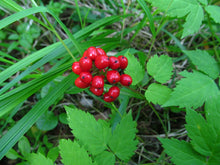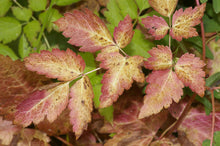
Actaea rubra
Western red baneberry is a three season-stunner that's relatively difficult to find in plant nurseries - so get it while you can! In early spring, its attractive compound leaves adorn the forest floor or woodland garden. By April, it begins to bear dense, cylindrical clusters of white, fragrant flowers. The flowers mature into berries that begin green but graduate to lustrous red, as summer progresses, and are gobbled up by backyard birds who are critical in dispersing their seed. Finally, the leaves transform into unique and delightful hues of pinks and reds each fall, before dying back entirely until the following spring.
- Plant type/canopy layer: deciduous, perennial, herbaceous plant
- Size at maturity: 12”-36” tall, 12”-24” wide
- Light requirements: full to partial shade
- Moisture requirements: moist soil
- Bloom time: April - July (April - June in the Portland Metro area)
- Growth rate/ease: slow to medium growth rate, moderately difficult to grow
- Wildlife support: flowers attract and provide nectar for adult butterflies, bees and other insect pollinators; overall plant is a caterpillar host plant and larval food source for the white-lined sphinx moth (Hyles lineata)
- Native habitat/range: found intermittently in deep soil pockets of moist conifer or mixed forests, streambanks, forest edges and slopes, at low to subalpine elevations, from western Alaska to southwestern California. Present in most Oregon counties, for the exception of the most desert areas. Portland Plant List - yes.
- Special features & uses: deer resistant; traditionally the juice from the fruits can be used to poison arrows thereby increasing their effectiveness; medicinally the root can be used as a strong anecdote for menstrual cramping and menopausal discomfort; landscape uses include pollinator gardens, woodland gardens and riparian bank stabilization
Gardening with Baneberry: Provided your woodland garden has naturally moist soils, or you’re willing to water occasionally during the summer drought, baneberry is a splendid and rare find, highly sought after for its attractive holly-like berries and compact form. Though, like many plants, it prefers well-drained soils that are rich in organic matter, it can tolerate soils well beyond this profile, as long as sufficient moisture is available. It is not fast growing and can take several years to grow large enough to flower. It will flower best in areas with dappled sunlight, as opposed to deep shade.
Photo Credit 1: "Actaea rubra Baneberry" by David A. Hofmann is licensed under CC BY-NC-ND 2.0
Photo Credit 2: "Actaea rubra (red baneberry), Ashford, CT" by Doug_McGrady is licensed under CC BY 2.0.
Photo Credit 3: "Actaea rubra (red baneberry), Johnston, RI" by Doug_McGrady is licensed under CC BY 2.0.
Photo Credit 4: "Воронец красный - Actaea rubra" by assanarin is marked with Public Domain Mark 1.0.
Photo Credit 5: "BANEBERRY, WESTERN (actaea rubra) (7-6-08) coon ck, montana de oro s p, san luis obispo, ca -2" by Sloalan is marked with CC0 1.0.





